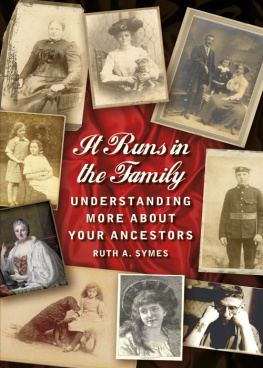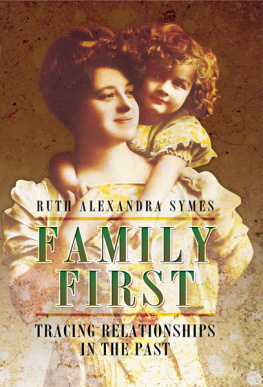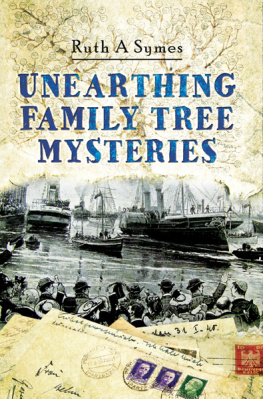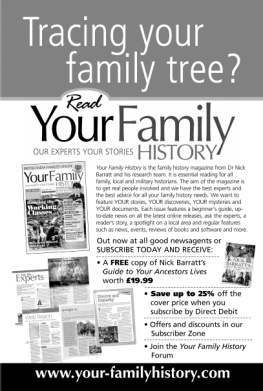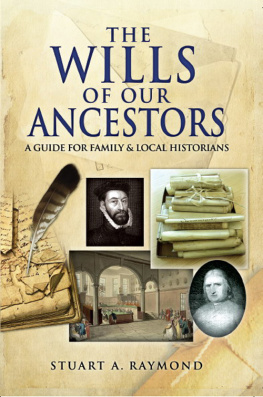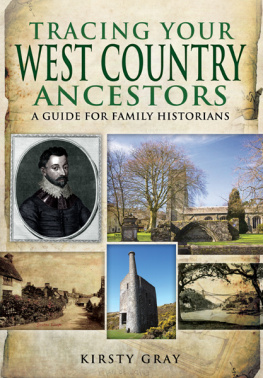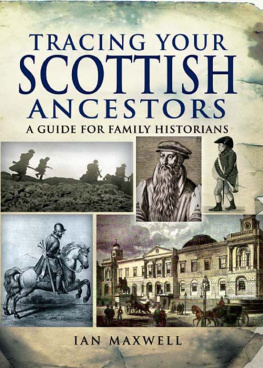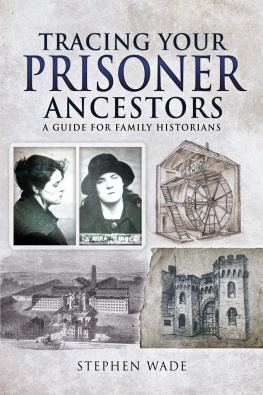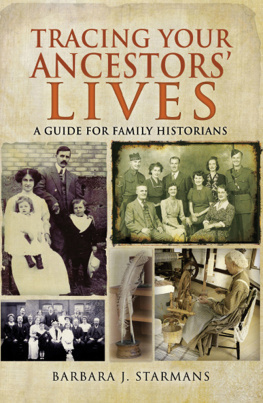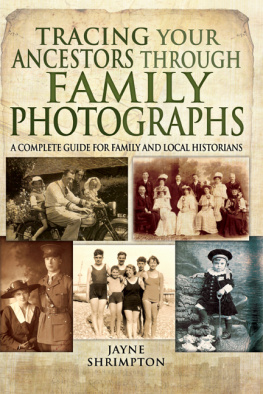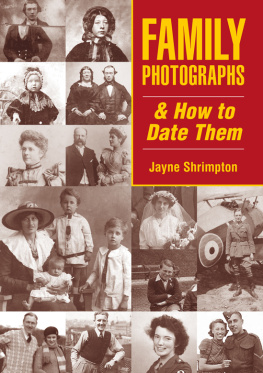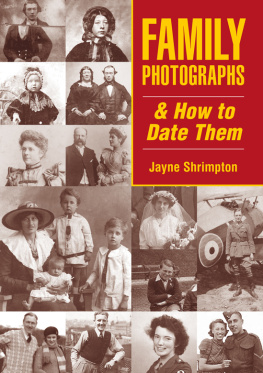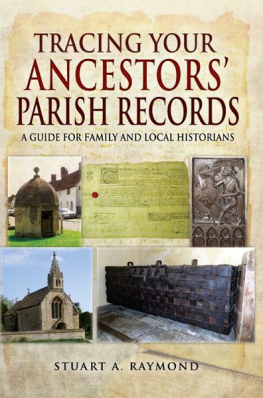
For Billy, Ruby and Robertson,
heralds of a new generation.
Contents
AN INTIMATE GUIDE TO OUR ANCESTORS AND THEIR TIMES
H ow often have we all returned to old photographs, written records and objects that we have inherited from our ancestors, hoping that simply by doing so they will somehow magically throw up more of their secrets? But historical ephemera can be frustratingly unforthcoming if we are not sure how to read them. More often than not we may close the photograph album, return the document to its envelope, or put the object back on its shelf with a sense of dissatisfaction. Our ancestor remains clouded in mystery a person unknown. This book aims to show you new ways of looking at your family history material in order that you may better understand the times (or, more correctly, the culture) in which the photograph was taken, the record made or the object used, and through this process allow your ancestor finally to step out of the shadows and make him or herself better known to you.
Everything from the past from a collar stud to a whiff of perfume is a product of its era and can be interpreted as such. How your ancestor chose to show his cufflinks, design his tattoo or even shape her eyebrows has a great deal to do with the prevailing norms and beliefs of the period in which he or she was living. In this way of looking at things, a hairstyle in an old photograph is not just a matter of personal grooming but might indicate all sorts of information about your ancestor, from age and health to social class, and even position in the family. Likewise, how your ancestor wore his beard may lead you to speculate on his religious or military associations, as well as his manliness or personal attractiveness. And the story behind your ancestors wedding ring might reveal something of her class status, her religious background, her income level and even her employment status as well as, more obviously, her romantic life.
This book focuses mainly on the period from the beginning of the nineteenth century to the 1950s. During this time photographic records first became available to the general public, more official documentation was collected on ordinary people than ever before and mass consumerism meant that families owned many more material objects than they had done in earlier centuries. In the Victorian and Edwardian periods, and later in the twentieth century, many people visited photographic studios, created photo albums and came to own cameras of their own. The state also played its part in recording the more personal and intimate aspects of our ancestors lives, through ten-yearly censuses, prison records, transportation records, military records and hospital records, to name but a few. Many of these records have now been made available to the family historian through the wonders of easily (and often freely) searchable Internet databases. Many, many more fascinating documents, including newspapers, diaries, letters and wills, lie in archives dotted around the country waiting to be examined. And there are other more tangible personal items: locks of hair, half-used bottles of aftershave, pressed flowers, and buttons and brooches, stashed away in attics and garages, lodged between the pages of old books and nestled in family jewellery boxes all of which may tell their own tale.
Social historians have written about all the aspects of ordinary life that interest people researching their families in the past, from the state of the nations teeth, diet, height and weight, to the ins and outs of the practice of shaving, the legal and economic connotations of wearing a wedding ring, and even the business of keeping a dog. One of the aims of this book is to make some of this research (including fascinating examples from magazines, poetry, novels and documentary studies of the past) accessible to the ordinary reader. Imagine history itself as a thick lock of hair: at whatever point you cut through it there will be multiple strands that make up that particular moment. This book looks at some of these strands: the superstitions and scientific beliefs, the fashions and medical advice, the developing manufacturing processes, penal laws, the situation of women and the condition of the working class, all of which characterised British society in the not-so-distant past. It will describe the role of empire, the horrors and deprivations of the two world wars, the development of criminal anthropology, the rise of national sovereignty and the cult of celebrity. And on the domestic front it will touch upon new ideas about weight, diet, personal cleanliness, correct behaviour and even sexuality that might have impacted on our ancestors experiences. In short, this book touches on many of the threads that made society what it was at any given moment in the past. In glimpsing some of these, it is hoped that you will come to understand more about your ancestors as products of their times and through that will come to understand them better as individuals as well.
Family history is not just an academic exercise, of course, and this book will include such practical genealogical matters as how to find out where and when ancestors who worked in particular professions (such as dentists) practised, and advice on making educated guesses about inherited belongings why your ancestor might have chosen a particular stone in her engagement ring, for example. The Find Out More sections at the end of each chapter will point to ways in which you can extend your knowledge and understanding of a particular topic through other books and websites. Of course, these resources are just the tip of the iceberg. The recent information revolution has made an almost infinite number of sources on any given subject available in our own homes at the touch of a button. Starting with the small matters of physical characteristics and personal effects, this book will give you strategies for sifting through some of this information and picking out what might be relevant to your family story.
There are a number of things that this book doesnt do. It does not, for example, offer scientific explanations on how physical characteristics might have been inherited; simple explanations of genetics are available on the Internet. Secondly, it does not offer a comprehensive history of photography, or an analysis of aspects of dress (or the other large props and backdrops) often visible in old photographs. These are topics much more ably addressed by my fellow family historians Jayne Shrimpton and Robert Pols. A list of some of their books on those subjects follows.
In family photographs from the past our ancestors stare out at us, somehow imploring us to understand them. The personal and official documents that record their lives likewise beg to be examined time and time again, and we have all turned over and over in our hands the objects that they used regularly, as if just by doing so we might come to know the people of the past better. This book should act as a magnifying glass turned on to that evidence, giving more prominence to these small matters. It should also act as a reading lamp, throwing light into the shadows and allowing you finally to get close to your ancestors in ways that you might never have believed possible.
FIND OUT MORE
Jayne Shrimpton, British Working Dress , Shire, 2012.
Jayne Shrimpton, Family Photographs and How to Date Them , Countryside Books, 2008.
Jayne Shrimpton, How to Get the Most from Family Photographs , Society of Genealogists Enterprises Ltd, 2011.
Robert Pols, Dating Old Photographs , second edition, FFHS Publications, 1998.
Robert Pols, Understanding Old Photographs , Robert Boyd Publications, 1995.
www.nationalarchives.gov.uk the National Archives.
Next page
